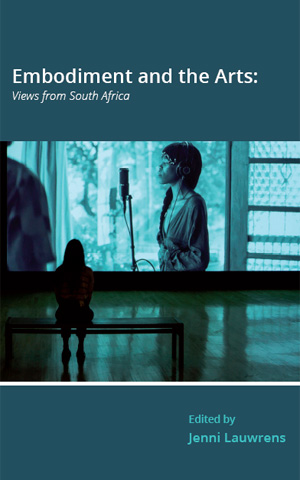Embodiment and the Arts: Views from South Africa
Edited by Jenni Lauwrens
2022
ISBN: 978-1-7764117-1-9
Pages: 311
Print version: Available
Electronic version: Free PDF available
About the publication
Embodiment and the Arts: Views from South Africa presents a diversity of views on the nature and status of the body in relation to acting, advertisements, designs, films, installations, music, photographs, performance, typography, and video works. Applying the methodologies of phenomenology, hermeneutic phenomenology, embodied perception, ecological psychology, and sense-based research, the authors place the body at the centre of their analyses. The cornerstone of the research presented here is the view that aesthetic experience is active and engaged rather than passive and disinterested. This novel volume offers a rich and diverse range of applications of the paradigm of embodiment to the arts in South Africa.
Table of Contents
List of figures
List of tables
Acknowledgments
Notes on contributors
PART 1 Conceptualising embodiment and the arts
Chapter 1
Embodiment and the arts in context
Jenni Lauwrens
1 Plotting a course
2 Embodiment
3 Aesthetic embodiment
4 The sensorium
5 Too deep for words?
6 Overview of chapters
Chapter 2
Enactive cognition in improvising musical ensembles: A South African perspective
Marc Duby
1 Introduction
2 The promise of embodied cognition
3 4E cognition: A brief overview
4 Musicking and enactive cognition
5 Conclusion
PART 2: Sensory scholarship
Chapter 3
Sight/site-specific recording: Embodiment and absence
Marc Röntsch
1 Introduction
2 Background
3 Embodiment and artistic research
4 Jazz ensemble playing
5 Blinding
6 On absence
7 Conclusion
Chapter 4
The art of touch in remote online environments
Jenni Lauwrens
1 Introduction
2 The significance and boundaries of touch
3 Out of touch
4 Holding hands over the internet: Telepresence, co-presence and the promise of digital touch
5 Chasing the Holy Grail of touch
6 Haptic visuality and the memory of touch
7 Conclusion
Chapter 5
Outer space and sensory deprivation (or why is outer space so bland?)
Amanda du Preez
1 Introduction
2 On blandness
3 What does outer space smell, taste and look like?
4 Falling down or falling up?
5 Gravity mimicked
6 Unfolding within the fourfold
7 Conclusion
Chapter 6
The typographic sensorium: A cross-modal reading of letterforms
Kyle Rath
1 Introduction: Function(s) of type
2 Design and the typographic sensorium
2.1 Sight: Type as image
2.2 Touch: Type as haptic and kinaesthetic
2.3 Sound: Type as wave-form
2.4 Olfaction: Type as scent and taste
3 Conclusion PART 3: Material presence
Chapter 7
A haptic and humanising reading of the subjects of studio portraits and asylum photography in colonial South Africa
Rory du Plessis
1 Introduction
2 The Black Photo Album
3 Interpreting photographs from the Orange Free State Asylum, c 1900
3.1 First encounter
3.2 Second encounter
4 Conclusion
Chapter 8
Athi-Patra Ruga’s politics of disorientation: Queer(y)ing threads
Adéle Adendorff
1 Introduction
2 Spinning tales and fashioning avatars
3 The politics of disorientation
3.1 Queer(y)ing phenomenology
3.2 Miss Congo and the table in the drawing-room
4 Casting off: Tying up loose threads
Chapter 9
Seeing an image at the University of Pretoria’s Africana collection in context
Sikho Siyotula
1 Introduction
2 The grass at the University of Pretoria’s gates
3 The world visualised in Ethnic map of Southern Africa
4 Visualising the Nguni estate or Shakan period
5 Visualising the Mapungubwe and Zimbabwe estate
6 Conclusion
PART 4: Embodied performance and composition
Chapter 10
Navigating dissonance: Bodymind and character congruency in acting
Èmil Haarhoff, Marth Munro and Marié-Heleen Coetzee
1 Introduction
2 Bodymind and embodiment
3 Acting as an embodied craft
4 Actor-character dissonance and heightened awareness
5 Navigating actor-character dissonance
5.1 Choice and reappraisal
5.2 Actively applying heightened bodymind awareness
6 Conclusion
Chapter 11
Advocating the importance of nonverbal communication in multimodal actor training
Elri Wium and Janine Lewis
1 Introduction
2 Case control study
3 Nonverbal communication as an analysis model
4 Discussion of syncretic behavioural communication design
5 Data collection and analysis through a mixed-methods approach
5.1 Observation study
5.2 Analysis of habitual characterisation (coded narrative recordings)
5.3 Assessing the semi-structured interviews
6 Conclusion
Chapter 12
Embodied composition ontologies, process and technology: Gesture heuristics and creative potential in music
Miles Warrington
1 Introduction
2 Creative spaces
3 Compositional approaches, processes and models
3.1 Gesture schemas and embodiment of sound
3.2 Gesture signification
3.3 Problem solving and gesture models
3.4 Hyperinstruments
4 Conclusion
Index
